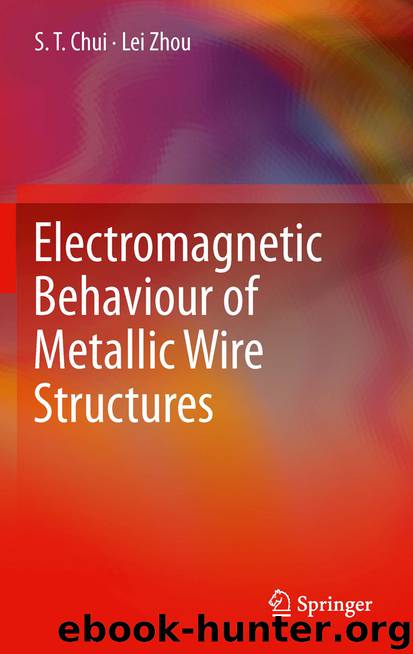Electromagnetic Behaviour of Metallic Wire Structures by S. T. Chui & Lei Zhou

Author:S. T. Chui & Lei Zhou
Language: eng
Format: epub
Publisher: Springer London, London
with the inverse transform
(5.1a)
Here is the two end of a wire segment, is an integer, and where d is the wire length. Different from the single wire case, the currents at the two ends of a wire segment are no longer symmetrically related to each other. In the Fourier expansion, we have doubled the period to take this into consideration. The issue of padding is well-known in algorithms for fast Fourier transforms. There are different ways by which the function X can be extended to this new region. If one is careful, the result will be the same. One way is to set X to be symmetrically related to that in the original domain: for . We have chosen to set the current and the charge densities to be zero from to x 2 . Thus the range of integration in Eq. (5.1a) is then only of size d for those functions. If only the components with even h are nonzero, we retrieve the result of the previous sections of a single wire. With this choice, there are some mathematical issues which fortunately do not invalidate the final answer. We shall discuss this at the end of this chapter.
As usual the “inductive” and the “capacitive” electric fields can be recast into a matrix form in terms of the wire currents and impedances
Download
This site does not store any files on its server. We only index and link to content provided by other sites. Please contact the content providers to delete copyright contents if any and email us, we'll remove relevant links or contents immediately.
| Automotive | Engineering |
| Transportation |
Whiskies Galore by Ian Buxton(40603)
Introduction to Aircraft Design (Cambridge Aerospace Series) by John P. Fielding(32359)
Small Unmanned Fixed-wing Aircraft Design by Andrew J. Keane Andras Sobester James P. Scanlan & András Sóbester & James P. Scanlan(32154)
Craft Beer for the Homebrewer by Michael Agnew(17467)
Turbulence by E. J. Noyes(7068)
The Complete Stick Figure Physics Tutorials by Allen Sarah(6654)
Kaplan MCAT General Chemistry Review by Kaplan(6078)
The Thirst by Nesbo Jo(5810)
Bad Blood by John Carreyrou(5794)
Learning SQL by Alan Beaulieu(5440)
Weapons of Math Destruction by Cathy O'Neil(5064)
Man-made Catastrophes and Risk Information Concealment by Dmitry Chernov & Didier Sornette(4764)
iGen by Jean M. Twenge(4712)
Digital Minimalism by Cal Newport;(4595)
Life 3.0: Being Human in the Age of Artificial Intelligence by Tegmark Max(4530)
Audition by Ryu Murakami(4117)
Electronic Devices & Circuits by Jacob Millman & Christos C. Halkias(4058)
1,001 ASVAB Practice Questions For Dummies by Powers Rod(4054)
Pale Blue Dot by Carl Sagan(4027)
